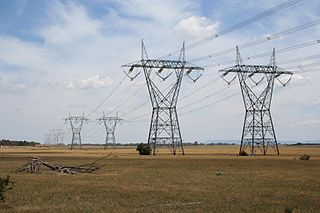
Richmond Power Station was a coal fired power station which operated on the banks of the Yarra River in Richmond, Victoria, Australia from its construction in 1891 until its closure in 1976. It was one of the first alternating current (AC) electricity generation plants in the state. It has since been converted into office space and is the headquarters of international fashion brand Country Road and advertising agency CHE Proximity. The area in which it is located is now called Cremorne.

The Yallourn Power Station, now owned by EnergyAustralia a wholly owned subsidiary of the Hong-Kong-based CLP Group, is located in the Latrobe Valley of Victoria, Australia, beside the Latrobe River, with the company town of Yallourn located to the south west. Yallourn PS was a complex of six brown coal–fired thermal power stations built progressively from the 1920s to the 1960s; all except one have now been decommissioned. Today, only the 1,450 megawatts (1,940,000 hp) Yallourn W plant remains. It is the second largest power station in Victoria, supplying 22% of Victoria's electricity and 8% of the National Electricity Market. The adjacent open cut brown coal mine is the largest open cut coal mine in Australia, with reserves sufficient to meet the projected needs of the power station to 2028. On 10 March 2021, EnergyAustralia announced that it will close the Yallourn Power Station in mid-2028, four years ahead of schedule, and instead build a 350 megawatt battery in the Latrobe Valley by the end of 2026. At the time, Yallourn produced about 20% of Victoria's electricity.

The State Electricity Commission of Victoria is a government-owned renewable electricity investment enterprise in Victoria, Australia. Originally a major energy supplier in the state, the SEC was privatised in the 1990s before being revived in 2023 to invest in renewable energy and storage.

The Energy Brix Power Station was a brown coal–fired thermal power station located at Morwell, in Victoria, Australia. The power station was used to supply electricity for the retail market, as well as the production of briquettes in the adjacent Energy Brix briquette works. It was shut down in August 2014 and is currently the earliest surviving large-scale power station designed to provide electricity to the state electricity network.

Spencer Street Power Station was a Victorian era coal and (later) oil-fired power station which operated on Spencer Street in central Melbourne, Victoria, Australia. The station was opened in 1894, and supplied power to the city's residents, as well as being a wholesale supplier to other municipal distributors. It came under the management of the State Electricity Commission of Victoria in 1941. By the 1960s the capacity of the station reached 109 MW, but was used only for peak load. The station was closed in 1982 after becoming redundant. Eventually deemed an eyesore, demolition commenced in 2006 and was completed in 2008.

The Newport Power Station was a complex of power stations located on the west bank of the Yarra River, approximately 6 km south-west of Melbourne, Victoria, Australia, in the suburb of Newport. Newport A, B, and C were coal-fired plants which operated at the site between 1919 and the 1980s, and were claimed to be the largest power station in the southern hemisphere in 1953 with 42 boilers and 14 turbo-alternators producing 327 megawatts (439,000 hp).

Energy in Victoria, Australia is generated using a number of fuels or technologies, including coal, natural gas and renewable energy sources. Brown coal, historically, was the main primary energy source for the generation of electricity in the state, accounting for about 85% of electricity generation in 2008. The amount of coal-fired power has decreased significantly with the closure in 2017 of the Hazelwood power station which supplied around 20% of Victoria's electricity, and to a lesser extent with the exit of Anglesea power station in 2015. Brown coal is one of the largest contributors to Australia's total domestic greenhouse gas emissions and a source of controversy for the country. Australia is one of the highest polluters of greenhouse gas per capita in the world.

Kearsley Power Station was a coal-fired power station in Stoneclough, near Kearsley, Bolton, England. It was designed in 1927 by Dr H.F. Parshall for the Lancashire Electric Power Company. The original installation was known as Kearsley 'A', comprising two British Thomson-Houston (B.T.H.) turbo-alternators rated at 32.25 megawatts each. Further extensions became Kearsley 'B' (1936/38), with two more B.T.H. turbo-alternators each capable of producing 51.6 megawatts. Finally Kearsley 'C' (1949) was completed with two more B.T.H. machines rated at 52 megawatts each. The station closed in 1980 when only 'B' station remained operational. The 5 cooling towers were demolished during the week of 14 May 1985.

The Yallourn 900 mm railway was a 900 mm narrow gauge railway operated by the State Electricity Commission of Victoria in the Latrobe Valley of Victoria, Australia. The railway was built for the haulage of brown coal and overburden between the Yallourn open cut mine, briquette works, and power station. The Morwell Interconnecting Railway (ICR) was later constructed, linking the Yallourn mine complex with the Hazelwood open cut, briquette works, and power station.

Shoreham Power Station is a 420MWe combined cycle gas-fired power station in Southwick, West Sussex. It was built on the site of the Brighton B Power Station.

Carville Power Station refers to a pair of now partially demolished coal-fired power stations, situated in North East England on the north bank of the River Tyne at Wallsend. The two stations were built alongside each other on a riverside site about 5 mi (8.0 km) downstream of Newcastle upon Tyne. Carville A Power Station, the first station on the site was opened in 1904, and Carville B Power Station was opened in 1916 to its south.
Two different railway lines serviced Yallourn during its existence. Both were broad gauge branches from the main Gippsland line in Victoria, Australia. The first was a line branching from a junction at Hernes Oak, situated between Moe and Morwell, which was in service from 1922 to 1955. The second Yallourn railway line junctioned at Moe, and was used between 1953 and 1986.
Neptune Bank Power Station was a coal-fired power station situated on the River Tyne at Wallsend near Newcastle upon Tyne. Commissioned in 1901 by the Newcastle upon Tyne Electric Supply Company, the station was the first in the world to provide electricity for purposes other than domestic and street lighting. It was also the first in the world to generate electricity using three-phase electrical power distribution at a voltage of 5,500 volts.

North Tees Power Station refers to a series of three coal-fired power stations on the River Tees at Billingham in County Durham. Overall, they operated from 1921 until 1983, and the C station, the last on the site, was demolished in 1987. Billingham Biomass Power Station is to be built on their site.
Close Power Station was a coal-fired power station situated on Newcastle upon Tyne's Quayside, in modern Tyne and Wear. The station was built by the Newcastle and District Electric Lighting Company in 1902, near their Forth Banks Power Station.

Taylors Lane Power Station is situated in Willesden, north-west London. The first power station on the site, known as Willesden power station, was coal-fired and operated from 1904 to 1972 and was subsequently demolished. Taylors Lane is now an open cycle gas turbine (OCGT) power station built in 1979.

Exeter Power Station is a former coal-fired power station on the River Exe quayside, Exeter, England.
Hayle Power Station was a coal-fired power station situated at the mouth of the River Hayle, at Hayle in Cornwall, South West England.
Upper Boat power station supplied electricity to the town of Pontypridd and the wider area from 1904 to 1972. The power station was developed in several stages firstly in 1902, then from 1924 to 1942. It was owned and operated by the South Wales Electrical Power Distribution Company until the nationalisation of the electricity supply industry in 1948. The station was decommissioned in 1972 and was demolished in 1976.
The Thornhill power station generated and supplied electricity to the town of Dewsbury and the wider regional area from 1902 to 1982, and again from 1998. The first generating station on the site was owned and operated by the Yorkshire Electric Power Company. Following nationalisation of the British electricity supply industry in 1948 Thornhill power station was operated by a succession of state owned bodies. The power station was redeveloped with new plant in 1915, 1925, 1932–37 and 1950–54. The coal-fired steam station was decommissioned in 1982, and was subsequently demolished. A gas turbine power station on the site was commissioned in 1998.

















